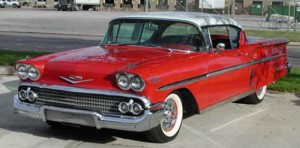Rock and Roll in the Sticks
Western Colorado in the late 1950s and 1960s was a cultural backwater of the first magnitude. I-70 did not exist, making travel to Denver at least two hours longer than now. In Grand Junction, there was one television station and two radio stations. The Junction had the Daily Sentinel newspaper, and Fruita had the Fruita Times, a weekly with stories about the bridge club.
Things were on the move in the land. Rock and Roll had appeared, but not in our neck of the desert. The only contact we had was the Ed Sullivan Show, which introduced Elvis to the world. The local radio stations weren’t interested. They were making money playing Patti Page, the Andrews Sisters, and Doris Day. The raciest they got was letting Johnny Ray cry.
At first, we found Lucky Lager Dance Time on KNBC in San Francisco, but you needed a good radio, and there better not be any lightning between the Junction and California. Then, salvation! KOMA! As soon as the sun was down, KOMA boomed in from Oklahoma City. Rock and Roll ruled the sticks. And the sticks were extensive. KOMA dominated Oklahoma, New Mexico, Rural Colorado, Kansas, Nebraska, South Dakota, Wyoming, and neighboring boondocks.
That radio station was our lifeline to the rock and roll youth culture developing in the country. This was not the Beatles and the Stones. It was Buddy Holly, Elvis, the Everly Brothers, all those Phil Spector bands, and some R&B, like Chuck Berry and Little Richard. KOMA was top 40, no obscure bands, just the big stuff. Yes, there was country and western, and Grand Junction even got a station later, but country was mostly confined to the pool halls and beer joints around 1960.
There was the KOMA band circuit. There were several rock and roll bands that traveled the region, playing in small town Grange Halls, Legion Halls; anywhere the band could rent a hall. Sterling, Roswell, Scott’s Bluff, Colby, Torrington, Hot Springs, Alliance, Garden City, Trinidad, all those little towns starved for anything from the outside world. The only band on the circuit I remember was Spider and the Crabs. They advertised their gigs on KOMA and kids came to the dances from all over. KOMA made money from the ads, and bad rock and roll ruled the boondocks.
Several of us would buy a case of Coors bottles, go to Grand Junction, listen to KOMA, cruise all evening drinking beer, and throw the empty bottles at highway signs on the way back to Fruita.
Was that youth misspent? No, not at all. I am writing about it now, aren’t I? Rock and Roll survived, and all was well until the mid-1960s. Here’s to KOMA in Oklahoma! The station is still in business, still playing rock and roll.
